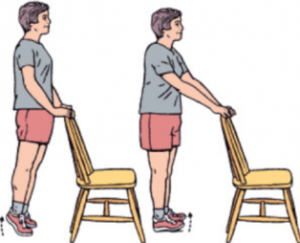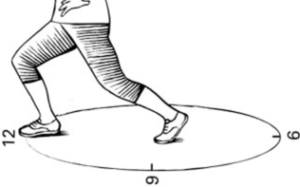Article by Jessica Darmago
Why is balance important?
We all know how important it is to have a balanced lifestyle and a balanced diet. Maintaining physical balance however, is often underestimated and overlooked, and is especially important in the older generation.
Although our balance generally declines as we age, with regular practice and training we can improve our balance and decrease the risk of falls. It is estimated that 30% of Australians over the age of 65 experience at least one fall per year due to imbalance, which accounts for 40% of injury related deaths (1). Fractures resulting from falls cause death in 25% of cases, and of those that survive only 1/3 regain complete mobility (1). Falls can lead to hospitalisation, decreased mobility, function and independence as well as a lower quality of life (2). Therefore, regular exercise and balance training is recommended to help prevent the risk of falls.
What is balance?
Balance is the ability to maintain the body’s center of mass over its base of support. It involves input from our visual system (sight), proprioception (ability to recognize where our limbs are) and the vestibular system (spatial orientation).
Getting older can affect one or more of these components in your body, which can ultimately affect our balance. Other factors that could impact balance are; disease, sight loss, injuries, decrease in reaction times or certain drugs (3-4). Psychological factors can also impact one’s balance, for example the simple fear of falling can increase the risk of having a fall (5).
Benefits of balance training
The benefits of balance training include:
- Making daily living activities easier
- Encouraging a positive and active lifestyle
- Helps prevents falls and injuries (6)
What balance training should I do?
Balance is more than just being able to stand on one leg. We have formulated a set of exercises that are used specifically to help and improve balance.
Ankles:
Our ankles are ‘activated’ when there is a small nudge or push that disrupts our center of gravity. The small movements and strength in our ankle work to keep us upright (7).
Exercise
- Try the heel-toe rocking exercise: Stand with feet shoulder width apart. Gently rock weight forwards and back between your heels and toes. Repeat 10 times. Note: If you are new to this exercise, to help keep you balanced you can use the back of a chair to hold onto.

Hips:
When a bigger push or nudge compromises our center of gravity, our hips are what’s used to counteract this. The hips move in the opposite direction of the push to help stabilise the body (7).
Exercise
- Try the arabesque exercise: stand on your left leg, tip the body forwards at the hips extending your right leg out behind you until it reaches 90 degrees. Reverse the motion to come back to standing. Repeat 5 times then switch to the other leg.

Stepping:
This is the final balance component and is used when there is a more forceful push where ankles and hips are insufficient in maintaining balance. This is when you need to take a step to compensate for the loss of balance (7).
Exercise
- Try the clock lunge exercise: Stand with feet together and image you are in the center of a clock face. Take a lunge forwards to 12 o’clock then come back into the center. Repeat this stepping the foot to 3 o’clock, 6 o’clock and 9 o’clock to challenge yourself. Then repeat with the other leg.

Effective balance requires the necessary range of motion in ankles and hips, as well as the muscular strength and endurance to support the body (8). Regular exercise of the lower limbs such as squats, walking, jogging, and lunges can assist with this. Join our O2 Active classes or speak to our exercise physiologists who can assist you in finding a program to maintain and improve your strength, endurance and flexibility for optimal balance and falls prevention!
References:
- Info about falls | Australian and New Zealand Falls Prevention Society. (2019). Retrieved from http://www.anzfallsprevention.org/info/
- Karlsson, M. K., Magnusson, H., von Schewelov, T., & Rosengren, B. E. (2013). Prevention of falls in the elderly—a review. Osteoporosis international, 24(3), 747-762.
- Woolcott, J. C., Richardson, K. J., Wiens, M. O., Patel, B., Marin, J., Khan, K. M., & Marra, C. A. (2009). Meta-analysis of the impact of 9 medication classes on falls in elderly persons. Archives of internal medicine, 169(21), 1952-1960.
- Tinetti, M. E., & Kumar, C. (2010). The patient who falls:“It’s always a trade-off”. Jama, 303(3), 258-266.
- Delbaere, K., Close, J. C., Brodaty, H., Sachdev, P., & Lord, S. R. (2010). Determinants of disparities between perceived and physiological risk of falling among elderly people: cohort study. Bmj, 341, c4165.
- Tiedemann, A., Sherrington, C., Close, J. and Lord, S. (2011). Exercise and Sports Science Australia Position Statement on exercise and falls prevention in older people. Journal of Science and Medicine in Sport, 14(6), pp.489-495.
- Aftab, Z., Robert, T., & Wieber, P. B. (2016). Balance recovery prediction with multiple strategies for standing humans. PLoS One, 11(3), e0151166.
- Muehlbauer, T., Besemer, C., Wehrle, A., Gollhofer, A., & Granacher, U. (2012). Relationship between strength, power and balance performance in seniors. Gerontology, 58(6), 504-512.
